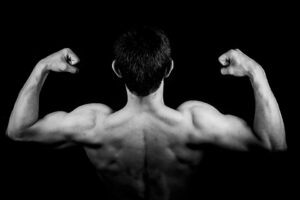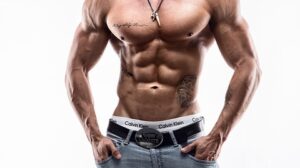Unleashing Strength: How the Muscular System Powers Our Every Move
Introduction
The human body is a marvel of biological engineering, a complex machine built to perform a multitude of functions. At the core of this functionality lies the muscular system, the intricate network responsible for movement, posture, and various other vital processes. This article will delve into the muscular system’s anatomy, physiology, and role in everyday life, uncovering how this remarkable system unleashes strength and enables us to perform countless activities.
The Anatomy of the Muscular System
The muscular system consists of three primary types of muscle tissues: skeletal, smooth, and cardiac. Each type serves unique functions and is structurally distinct.
1. Skeletal Muscle
Skeletal muscle is the most prevalent type, comprising approximately 40% of an individual’s body weight. These muscles are attached to bones via tendons and are under voluntary control. They enable us to perform movements ranging from simple actions like walking to complex athletic performances. Skeletal muscle fibers are long and cylindrical, composed of myofibrils that contain sarcomeres— the basic contractile units.
Structure of Skeletal Muscle
- Muscle Fibers: Long, cylindrical cells that can extend the entire length of the muscle.
- Myofibrils: Subunits of muscle fibers that contain the contractile proteins actin and myosin, which interact to produce contraction.
- Connective Tissue: Surrounds and supports muscle fibers, providing strength and stability.
2. Smooth Muscle
Found in the walls of hollow organs (such as the intestines and blood vessels), smooth muscle is involuntary and not under conscious control. It plays a critical role in regulating processes such as digestion and blood flow. The muscle fibers are spindle-shaped and lack the striations characteristic of skeletal muscle.
Functions of Smooth Muscle
- Involuntary Movement: Controls movements within internal organs.
- Regulation of Blood Flow: Smooth muscle in blood vessel walls helps maintain blood pressure.
3. Cardiac Muscle
Cardiac muscle is unique to the heart, facilitating its rhythmic contractions. Like smooth muscle, cardiac muscle is involuntary, but it possesses striations similar to skeletal muscle. Cardiac muscle fibers are interconnected, forming a network that allows for synchronized contractions, vital for effective blood circulation.
Key Features of Cardiac Muscle
- Intercalated Discs: Specialized connections between cardiac muscle cells that allow rapid electrical signals for coordinated contractions.
- Autonomic Regulation: Controlled by the autonomic nervous system, adjusting heart rate according to the body’s needs.
The Physiology of Muscle Contraction
Understanding how muscles contract is essential to appreciate their power and functionality.
1. The Sliding Filament Theory
At the heart of muscle contraction lies the sliding filament theory. This theory explains how muscle fibers shorten during contraction when the thick myosin filaments slide past the thin actin filaments within the sarcomeres.
Process of Muscle Contraction:
- Electrochemical Signal: A nerve impulse causes the release of calcium ions from the sarcoplasmic reticulum.
- Cross-Bridge Formation: Calcium binds to troponin, causing a change in the shape of tropomyosin, allowing myosin to attach to actin.
- Power Stroke: Myosin heads pivot, pulling the actin filaments, resulting in muscle shortening. ATP is essential for the myosin heads to detach and reset for another contraction.
2. Energy Sources for Muscle Contraction
Muscle contractions require energy, primarily in the form of adenosine triphosphate (ATP). Several energy pathways are involved in producing ATP:
- Phosphagen System: Provides immediate ATP through creatine phosphate, but is limited to short bursts of activity.
- Anaerobic Glycolysis: Breaks down glucose without oxygen, producing ATP for moderate-duration activities.
- Aerobic Respiration: Utilizes oxygen to produce ATP, ideal for sustained activities like long-distance running.
Types of Muscle Fibers
Muscles are composed of different types of fibers, each adapted for specific functions:
-
Type I Fibers (Slow-Twitch):
- Characteristics: Red fibers, rich in mitochondria, suited for endurance activities.
- Function: Resistant to fatigue, ideal for long-duration exercise (e.g., marathon running).
- Type II Fibers (Fast-Twitch):
- Characteristics: White fibers, larger in diameter, generate more force but fatigue quickly.
- Types:
- Type IIa: Intermediate fibers, capable of both aerobic and anaerobic metabolism.
- Type IIb: Primarily anaerobic, designed for short bursts of powerful activity (e.g., sprinting).
The Role of the Muscular System in Movement
Movement results from intricate interactions between the muscular system, the nervous system, and the skeletal system.
1. Agonist, Antagonist, and Synergist Muscles
Muscle actions involve various roles that different muscles play:
- Agonist Muscles: Primary movers responsible for a specific motion (e.g., biceps in elbow flexion).
- Antagonist Muscles: Oppose the action of agonists (e.g., triceps during bicep curls).
- Synergist Muscles: Assist agonists in performing actions (e.g., brachialis aids biceps in elbow flexion).
2. The Role of Muscle Tone
Muscle tone refers to the continuous and passive partial contraction of muscles, essential for maintaining posture and stability. It is regulated by the nervous system, ensuring readiness for movement and providing a baseline level of tension in the muscles.
The Muscular System and Fitness
Regular exercise plays a significant role in enhancing muscular strength and overall health.
1. Resistance Training
Resistance training stimulates muscle growth through progressive overload, promoting hypertrophy (muscle enlargement) and increased strength. This training can significantly affect muscle fiber composition, favoring the development of Type II fibers in many athletes.
Benefits of Resistance Training:
- Increases muscle mass.
- Enhances metabolic rate.
- Strengthens the skeletal system.
2. Aerobic Training
Aerobic activities improve cardiovascular fitness and promote an increase in Type I fibers, benefiting endurance performance. Regular aerobic exercise strengthens the heart, enhances lung capacity, and promotes better oxygen utilization.
Benefits of Aerobic Training:
- Improves cardiovascular health.
- Increases stamina and endurance.
- Reduces the risk of chronic diseases.
The Connection Between the Muscular System and Overall Health
A robust muscular system is integral to maintaining overall health and well-being.
1. Injury Prevention
Strengthening muscles can help support joints and reduce the risk of injury during physical activity. A strong core, for example, stabilizes the spine, reducing the likelihood of back pain and injuries.
2. Metabolic Impact
Muscle mass plays a crucial role in metabolism. More muscle means a higher resting metabolic rate, aiding in weight management and overall energy balance.
3. Mental Health
Engaging in regular exercise has been linked to improved mood and mental well-being. The release of endorphins during physical activity contributes to feelings of happiness and reduces stress.
Common Muscle Disorders
Despite the muscular system’s resilience, it can be affected by various disorders.
1. Strains and Sprains
Muscle strains involve overstretching or tearing of muscle fibers, often from improper lifting or excessive weight. Treatment typically involves rest, ice, compression, and elevation (RICE).
2. Muscular Dystrophies
Muscular dystrophies are a group of genetic disorders characterized by progressive muscle weakness and degeneration. Conditions like Duchenne muscular dystrophy require extensive medical management and physical therapy.
3. Myopathy
Myopathy refers to diseases that affect muscle fibers directly. Symptoms include muscle weakness, cramps, and pain, requiring medical intervention and tailored exercise plans.
Future of Muscle Research
Advances in research are enhancing our understanding of muscle function and rehabilitation.
1. Regenerative Medicine
Stem cell therapy and tissue engineering have the potential to revolutionize the treatment of muscular disorders, offering hope for individuals with degenerative diseases.
2. Biomechanics
Studying biomechanics helps optimize performance and minimize injury risks in athletes. Innovative technologies, like wearable devices, provide real-time feedback for training effectiveness.
Conclusion
The muscular system is a cornerstone of human movement, strength, and overall health. Understanding its complex structure and function emphasizes its critical role in our daily activities and well-being. Revolutionizing our knowledge of the muscular system can lead to improvements in training, injury prevention, and rehabilitation, showcasing the importance of maintaining muscular health for a lively and active life.
References
- Hall, C. (2019). Muscles and Movements: A Comprehensive Guide. Boston: Academic Press.
- Johnson, M., & Rickert, M. (2020). Exercise Physiology: Effects on the Muscular System. Journal of Sports Sciences, 38(4), 489-500.
- Brown, T. J., & Smith, R. L. (2021). Strength Training and Muscle Health. Sports Medicine Review, 75(3), 233-245.
- Williams, A. H. (2020). Understanding Muscle Fibers in Human Physiology. Journal of Anatomy, 238(6), 1227-1240.
- Anderson, L. K., & Thompson, D. G. (2022). Muscle Disorders: Advances in Treatment. Neurology and Therapy, 15(2), 163-177.
This comprehensive exploration of the muscular system highlights its importance and functionality, reflecting a deep appreciation for the strength it provides in our lives.

























Add Comment